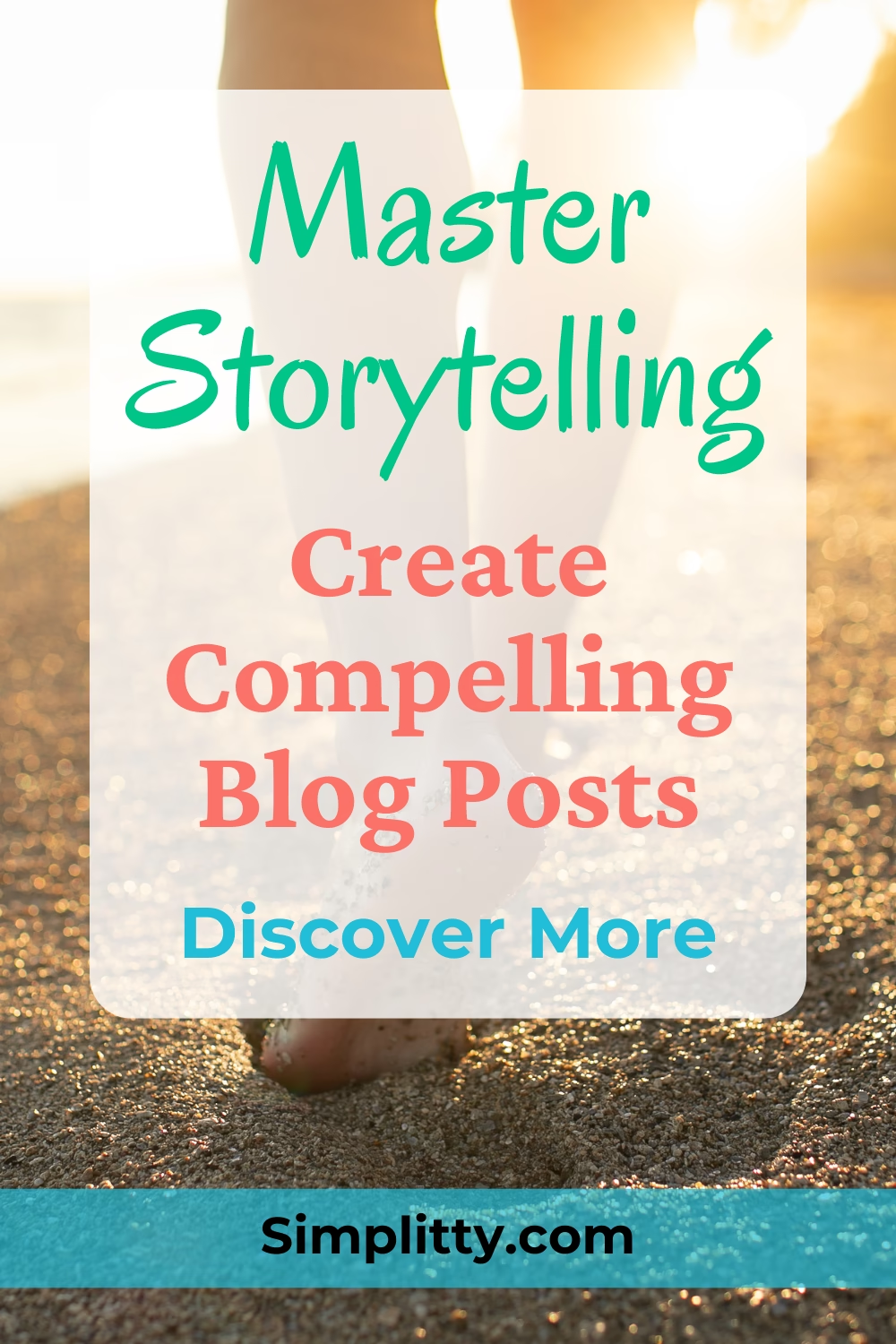Here you have questions to check your knowledge. Answers you will find in this blog post. Good luck!
Test your knowledge :)
The Power of Storytelling in Blogging

In the world of blogging, the art of storytelling holds immense power. Bloggers can engage their audience. They can leave a lasting impact through captivating narratives and compelling content. Storytelling in blogging goes beyond simply conveying information. It creates an emotional connection with readers, making them more likely to resonate with the shared message.
Blog posts incorporating storytelling can transport readers into a different world. They can capture readers’ attention from the beginning and keep them hooked until the end. Bloggers can create a sense of authenticity and relatability. It draws readers in by weaving personal experiences, anecdotes, or even fictional tales into their writing. Tell a story to your readers. I’m sure they will enjoy it.
The use of storytelling techniques allows bloggers to communicate complex ideas or concepts. it can be done in a more accessible and engaging manner. Instead of presenting dry facts or information, they can present it within a narrative framework. It’s easier for readers to understand and remember. This enhances the reading experience. Also, it increases the likelihood that readers will share the content with others. Becoming a storyteller is an excellent method to keep every reader’s attention.
Moreover, storytelling adds depth and personality to blog posts. It’s helping bloggers establish their unique voice and brand identity. Bloggers can connect with their audience on a deeper level by infusing their writing with personal stories or anecdotes. They can also build trust and loyalty over time.
We will explore various aspects of storytelling techniques used in blog posts. You will learn how effective storytelling can enhance engagement levels. You will know how to increase reader retention rates and drive traffic to your blog. Additionally, I will give you practical tips on incorporating storytelling into your blog writing for the greatest impact.
So join me as I embark on this journey through the world of storytelling in blogging. Let’s unlock its potential to captivate audiences. It’s time to create memorable experiences for both writers and readers alike. Welcome to my ultimate guide to storytelling!
Related: Want to know How to Start a Blog? Check my other posts.
Understanding the Essence of Storytelling

Defining Storytelling: A World of Imagination Unveiled
At its core, storytelling is a captivating fusion of words and ideas. It conjures new realms and experiences within the minds of readers or listeners. It’s a vehicle that evokes human emotions and impels people to embrace novel concepts and take transformative actions. The multifaceted nature of storytelling presents both a challenge and an opportunity. To navigate these waters effectively, let’s delve into some essential do’s and don’ts:
Quick Do’s and Don’ts for Crafting Compelling Stories
- Do: Infuse emotions to create resonance.
- Do: Craft original ideas that captivate.
- Do: Stir curiosity and unanswered questions.
- Don’t: Rely solely on stating facts.
- Don’t: Use jargon or business-speak.
- Don’t: Neglect the power of suspense.
Elevating Your Narrative: The Art of Storytelling

The Journey from Language to Artistry
From the dawn of human civilization, stories have been the vehicle through which cultures transfer shared beliefs and values. These tales have traversed thousands of years. They were shaping the collective narrative that defines our existence today. The transition from a basic story to a transformative narrative rests on key attributes that elevate storytelling to an art form:
Narrative: The Spine of a Great Story
Narratives are the lifeblood of great stories. Whether recounted in the pages of a Shakespearean play or from the lips of a stand-up comedian, the narrative draws its strength from the events unfolding within a unique setting. This interplay between narrative and setting creates a tapestry that resonates across time.
Captivating Attention: The Gateway to Connection
To merely tell a story is insufficient. To captivate attention is the true aim. Creating suspense engages the audience’s curiosity, leaving them yearning for answers. The art of “Show, don’t tell” breathes life into your narrative, painting vivid images that resonate deeply.
Interaction: The Dance Between Storyteller and Audience
Storytelling is a dance where the audience’s steps echo the storyteller’s lead. The engagement between the storyteller and the audience is the essence of this art.
Imagination Unleashed: Painting with Words
Storytelling invites audiences to craft their own mental tapestries. Movie adaptation may shape a reader’s visualization. Storytelling sparks detailed visions of characters, settings, and events. In essence, storytelling is akin to painting – a skill that every marketer, content writer, or PR professional can master.
Understanding the Elements of a Compelling Story

Character development: creating relatable and interesting characters in your blog posts.
Creating relatable and interesting characters in your blog posts is crucial in crafting a compelling story. When readers can connect with the characters, it enhances their engagement and makes the story more memorable.
Understanding your target audience and their interests is important to create characters. Consider their demographics, preferences, and pain points. This will help you develop characters that resonate with your readers personally.
When crafting these characters, give them depth. Provide them with unique personalities, motivations, and challenges. Readers should be able to empathize with their struggles and root for their success.
Additionally, make sure to incorporate character development throughout your blog post. Show how the character evolves or learns from their experiences as the story progresses. This adds depth and keeps readers invested in the narrative.
Furthermore, use vivid descriptions to bring your characters to life. Paint a picture of what they look like, how they speak or behave, and what makes them stand out. This will help readers visualize the characters in their minds and make them more memorable.
It is crucial to craft relatable and intriguing characters in your blog articles to capture your audience’s interest. Understanding your intended readers and constructing well-developed characters with captivating storylines is crucial. You can then produce narratives that resonate with your audience. Additionally, don’t forget that you can also assume the role of a character and tell your story. The choice is entirely yours.
Plot and structure: crafting a well-defined storyline that keeps readers engaged
Crafting a well-defined storyline is essential for captivating readers. It will keep them engaged throughout a piece of writing. The plot and structure of a story play crucial roles in achieving this goal. A carefully constructed plot provides a clear trajectory for the narrative. A well-thought-out structure ensures that the story flows smoothly and logically.
To create a compelling plot, it is important to establish a strong central conflict or goal that drives the story forward. This conflict should be relatable to readers and create tension or suspense. Introducing exciting characters with distinct personalities further enhances the plot. It’s adding depth and complexity.
In terms of structure, writers often rely on established storytelling techniques. These are the three-act structure or the hero’s journey. These frameworks help organize the narrative into distinct sections. It allows for effective pacing and development. Additionally, you can incorporate elements such as foreshadowing, subplots, and unexpected twists. It can add excitement and intrigue to the storyline.
Maintaining momentum throughout the narrative is crucial to keep readers engaged. This can be achieved by balancing action, dialogue, description, and introspection moments. By creating dynamic scenes that propel the story forward, writers can hold their readers’ attention. They can also prevent any lulls in interest.
Furthermore, using transitions between scenes or chapters helps maintain coherence in storytelling. Smooth transitions allow for seamless progression from one event to another. It happens without confusing or disorienting readers.
Overall, crafting a well-defined storyline requires careful planning and attention to detail. Establish an engaging plot with relatable conflicts. Use a practical structure that keeps readers hooked from beginning to end. This way, you can ensure your work captivates the audience’s imagination.
Tension and conflict: introducing challenges and obstacles to create suspense and drive the narrative forward
Tension and conflict are essential elements in storytelling. They captivate audiences and keep them engaged. By introducing challenges and obstacles, writers can create suspense. They can also drive the narrative forward. These obstacles can come in various forms. These are internal conflicts within characters or external forces that hinder their progress.
One of the main purposes of tension and conflict is to create a sense of anticipation and make readers or viewers invested in the story’s outcome. By presenting characters with difficult choices or putting them in high-stakes situations, writers can evoke strong emotions and keep audiences on the edge of their seats.
Challenges and obstacles also serve to develop characters and reveal their true nature. How characters respond to adversity can expose their strengths, weaknesses, values, and motivations. This adds depth to their personalities and allows readers or viewers to connect with them on a deeper level.
Furthermore, tension and conflict provide opportunities for character growth. As they face challenges head-on, characters may learn valuable lessons. They can overcome personal limitations or experience transformative journeys. These moments of growth enhance the narrative. They also resonate with audiences who can relate to the struggles faced by the characters.
In addition to driving the narrative forward, tension and conflict contribute to pacing. They prevent stagnation by introducing new complications that demand resolution. This keeps readers or viewers hooked as they expect how each challenge will be overcome.
Introducing challenges and obstacles in storytelling creates suspense. It engages audiences emotionally, develops characters, and facilitates character growth. Also, it maintains pacing and delivers a satisfying narrative experience.
Emotional connection: evoking emotions through storytelling to make your blog posts memorable

Creating a memorable and impactful post is essential to engage your audience in blogging. One powerful way to achieve this is by evoking emotions through storytelling. By weaving narratives that resonate with readers on an emotional level, you can create a lasting connection. It will leave a lasting impression.
Storytelling allows you to tap into the human experience. You can touch upon universal emotions such as joy, sadness, excitement, or even nostalgia. You can transport your readers into a different world and connect them to your content. You can do it through vivid descriptions and relatable characters or situations.
When crafting your blog posts, consider incorporating personal anecdotes or real-life examples. This way, you can illustrate your points. By sharing authentic experiences and emotions, you can establish credibility. Also, you can foster empathy from your audience.
Additionally, using descriptive language and sensory details can further enhance the emotional impact of your writing. Engage all five senses to paint a vivid picture in the minds of your readers, allowing them to immerse themselves in the story you’re telling fully.
It’s important to remember that evoking emotions doesn’t mean manipulating or exploiting them for the sake of engagement. Instead, focus on authenticity and genuineness in your storytelling. Connect with your readers by sharing stories that align with their experiences and tap into their emotions.
When you tell stories in your blog posts that make people feel something, it helps them remember better. This also makes it more likely for people to talk about your posts and become fans who keep coming back. Stories are like magic for your blog! So, when you’re making your next blog post, don’t be scared to explore your feelings. This could be what makes your post different from all the others online. Your emotions can make your post special!
Pacing: maintaining a balanced rhythm to hold readers’ attention throughout the post
Making sure people stay interested in what you write is really important. It’s like how music has a beat that keeps you listening. In writing, this is called “pacing.” Pacing helps your writing feel exciting and holds the reader’s attention all the way. You can mix short and long sentences, use strong words, connect your ideas smoothly, and add things like lists or headings. When you get the pacing right, your writing becomes easy to read. It highlights important stuff, creates excitement, and makes readers want to read everything!
The Role of Vivid Descriptions and Imagery in Storytelling

Making pictures with your words is super important when you tell a story. This helps people imagine they’re right inside the story. You can do this by adding details that use your senses, like how things look, smell, or feel. When you use strong and exciting words, your story becomes alive, and people can see it in their minds.
When writers use detailed and colorful words, it’s like they’re making a movie in the reader’s head. This makes the story feel even more real and interesting. They use words that help you imagine how things look, sound, smell, taste, and feel. This makes the story easier to understand. Also, you start feeling like you’re right there with the characters, having feelings about what’s happening.
When people write stories, they can use words to make you feel a certain way. You can almost see it in your mind if they talk about a beautiful sunset with orange and pink colors. Or if they describe the smell of fresh bread in a busy bakery, you can almost smell it! This helps you feel the mood of the story and makes it more interesting.
Also, when writers use clear and colorful words, it’s like they’re helping you see the characters, places, and things that are happening. This helps you understand the story and imagine it all in your head. They use words that make you think of how things look, sound, smell, taste, and feel. It’s like you’re not watching the story but right there with the characters, doing things with them.
In summary, vivid descriptions and imagery are essential components of effective storytelling. Authors can create rich mental images by incorporating sensory details into their writing. They captivate readers’ imaginations and make their stories truly come alive.
Incorporating Personal Anecdotes for Authenticity and Engagement

Adding your own personal stories when you write can make your blog posts better. Talking about things that happened to you helps your readers feel more interested and connected. It’s like you’re making them care more about what you’re talking about.
Telling stories, you can put your own experiences in your writing. This makes your writing relatable and easy to remember. Sharing a funny or heartwarming story adds a human touch to your writing, making readers connect.
Talking about your own experiences in your blog posts makes them more believable. When you share real things that happened to you, it shows that you really know what you’re talking about. This makes people trust you more and think you’re like a pro or someone who understands what they’re going through.
When you tell your stories, finding the right balance is good. You want to share enough so it’s interesting, but you should also keep some things private. Think about how your story connects to what you’re writing about and how it helps your main point.
Adding your own stories to your blog posts makes them more real and interesting. When you talk to your readers like this, they remember your writing better and like it more. It also makes people trust what you say and think you’re a good writer.
Crafting Compelling Headlines that Intrigue Readers from the Start

Crafting compelling headlines is a crucial aspect of copywriting that can impact the success of your content. In today’s fast-paced digital world, where attention spans are short, it is vital to grab readers’ attention immediately.
Compelling headlines are designed to intrigue readers and entice them to click and engage with your content. They serve as a powerful tool to capture your audience’s interest and make them curious about what lies within the article or blog post.
You need to know who you’re writing for to make headlines that get noticed and what they like. Your headlines should match what they want, like their needs or problems. Use words that make them feel things and make them curious.
Titles that make people curious are really good at getting their attention. You can make people want to click and read more by asking interesting questions or giving a little hint about something valuable they can learn.
Also, you can make your title even more interesting by using powerful action words, numbers, or things that make you stand out. These things tell readers what they’ll get from your writing and why it’s cool.
It’s important to make exciting titles that catch the eye, but it’s also really needed to do what you say in your writing. When you make a promise in your title, you need to keep that promise in what you write. This makes readers happy and helps them trust you for next time.
Making interesting titles means knowing who you’re talking to. It also means using words that make them feel things and asking questions that make them curious. When you get good at this writing skill, you can make people want to read your stuff and really get into it.
The Importance of Conflict Resolution and Lessons Learned in Your Stories

Solving conflicts is super important in stories because it makes them more interesting. When characters figure out how to fix problems, they change and improve. This makes stories really cool and easy for readers to connect with.
In stories, problems can happen because of different things. Sometimes it’s about what a character feels inside, and sometimes it’s about things happening outside. These problems make the story exciting and move it along, so readers want to know what will happen.
Solving problems in stories can teach us useful things for our lives. Sometimes, it’s about getting past things that bother us. Sometimes, it’s about handling tricky friendships or family stuff. Stories show us how to be strong, understand others, and figure out solutions when things go wrong.
Writers can teach us important stuff about life by showing different ways to fix problems in stories. They can talk about talking with others, finding middle solutions, saying sorry, or thinking about their actions. Stories help us learn how to make things better when there are troubles.
Ultimately, when stories talk about solving problems and what we learn, they become really strong and interesting. They make us think about our own lives and how we deal with problems. Stories can show us different ideas about fixing things when they go wrong in our world.
The Why Behind Stories: Unveiling Their Purpose

Stories: The Universal Communicators
Stories do many things, like making us have fun, teaching us stuff, and trying to sell things. But why do people like stories more than charts with numbers or lists? It’s because stories can make hard things easier to understand and turn ideas into something real that we can see in our minds:
Solidifying Abstract Ideas: A Bridge to Understanding
Big ideas can be confusing, but stories make them easier to get. It’s like when a teacher uses a story to show how a math problem works in real life. Stories help us understand things that might seem hard.
Promoting and Shaping Concepts: The Power of Influence
Stories have a long history of making people work together and act in specific ways in society. They’re different from numbers and facts because they touch our feelings, which can make us change how we act. Making stories is like showing people new ways to look at things and helping them know what to do.
Creating Community: Stories that Bind
Storytelling is like a language everyone can understand, no matter where they’re from. Stories make us all feel the same emotions, even if we speak different languages or have different cultures. Stories about heroes, people who are treated unfairly, and sad things are like stories we all get, and they make us feel close even if we’re far apart.
Inspiring Action: The Catalyst for Change
When brands are honest and authentic in their stories, they stand out and do not just seem like companies. Stories that make us feel something and tell about good things and bad things the brand did make people want to care and be part of it. Making stories that show real people run the brand we can trust makes us want to stick around and like the brand more. Stories are like magic for brands.
Closing Thoughts: Inspiring and Empowering Your Readers through Compelling Stories

No one can say no to amazing stories. Stories that make you feel strong and excited can make you want to do things and feel different. These great stories can make you feel strong emotions, like happiness or wanting to make a change. They also make you remember them for a long time.
When you share stories that really connect with the people reading them, you can make them want to do things and change how they live. This can happen because the characters in the story feel like people they know. Also, because the story makes them think deeply, or even because it gives them strong messages about hope and being tough. Stories can excite people and make them want to beat the harsh things they face.
Also, when you make your readers feel strong with your stories, you help them believe in themselves and what they can do. When you tell about people who beat big challenges or made the world better, it makes your readers feel like they can do great things, too. Stories can make your readers feel sure of themselves and want to follow their dreams. Use stories to help others feel awesome.
Stories that really grab your attention are super important in this digital time. People don’t focus for long, and there are many things to get distracted by. But stories stand out and make people really care. So, if you’re a writer or make things online, keep using the magic of stories to make people excited and robust. Start using storytelling today!
FAQ
What are the 4 types of storytelling?
There are four different ways to tell stories, using different ways to share them:
- One way is traditional storytelling, which uses talking and exciting words to get people interested.
- Another way is digital storytelling, which uses technology and pictures to tell stories.
- Visual storytelling is about using pictures to show stories and get people’s attention.
- And then, there’s storytelling in blog posts, which uses writing to share stories in a clear and informative way.
No matter what kind of story it is, all stories can make us interested and excited. They make us feel things and help us see we’re all alike through what we’ve been through. Stories help us know the world and people around us better. They remind us that we’re all connected and help us care about others. Whether we’re hearing stories, watching them, or making our own, storytelling is really important in our lives.
Can I tell stories on my blog?
Of course! Content marketing is like talking and making friends with the people who like what you say. Adding stories to your blog can be a super strong way to do this. It’s like using stories in a business can help you share your experiences and what you know in a way that’s fun to read.
If you use the right tricks for telling stories, you can make really cool posts that make your readers feel the same way you do and remember what you said. Some tricks are finding out who reads your blog, knowing what they like, and picking stories that fit what you talk about. It can be about something cool you did or a thing you sell or do. Using stories can make your blog posts really good at telling your message and making people like what you do.
So, go ahead and tell a story on your blog – it could help you connect with your readers more and make them really like what you say and do.
Book Your Trip with These Resources
Here are my go-to resources for planning a seamless and stress-free trip. I personally use these services and highly recommend them.
Flights and Transportation
- Skyscanner – Best for finding cheap flights worldwide.
- Kayak – Ideal for comparing multiple travel sites at once.
- Rome2Rio – A fantastic tool for planning multi-modal transportation routes.
Accommodation
- Booking.com – Best rates for hotels and guesthouses.
- Agoda – Best rates for hotels.
- Hostelworld – Perfect for budget travelers and solo adventurers.
- Airbnb – Great for unique stays and long-term rentals.
- HotelTonight – Awesome for last-minute hotel deals.
Travel Insurance
- SafetyWing – Comprehensive coverage for all travelers.
Trip Planning and Activities
- Get Your Guide – Find tours, skip-the-line tickets, and local experiences.
- Klook – Book tours, tickets, and activities at your destination.
Helpful Tools
- Google Translate – Break language barriers while traveling.
- SurfShark VPN – Stay safely connected wherever you go.
Don’t Forget to Read
Affiliate Disclosure: Some links above are affiliate links, meaning I earn a small commission if you purchase through them at no extra cost to you. These help me keep the blog running, so thank you for your support!











